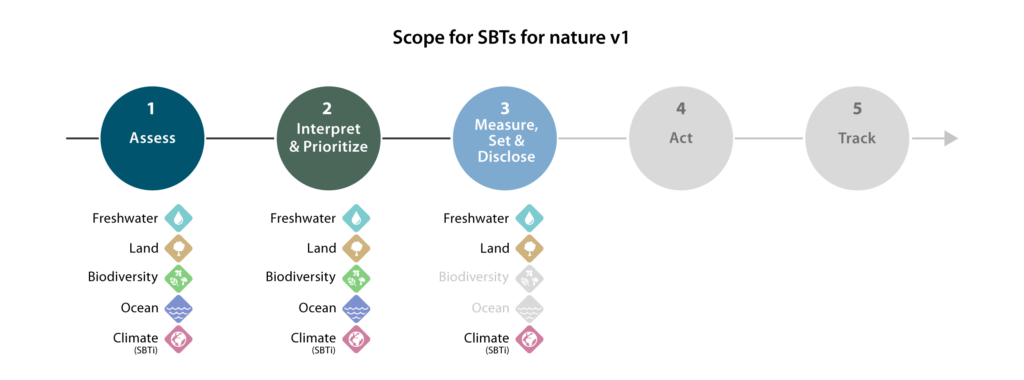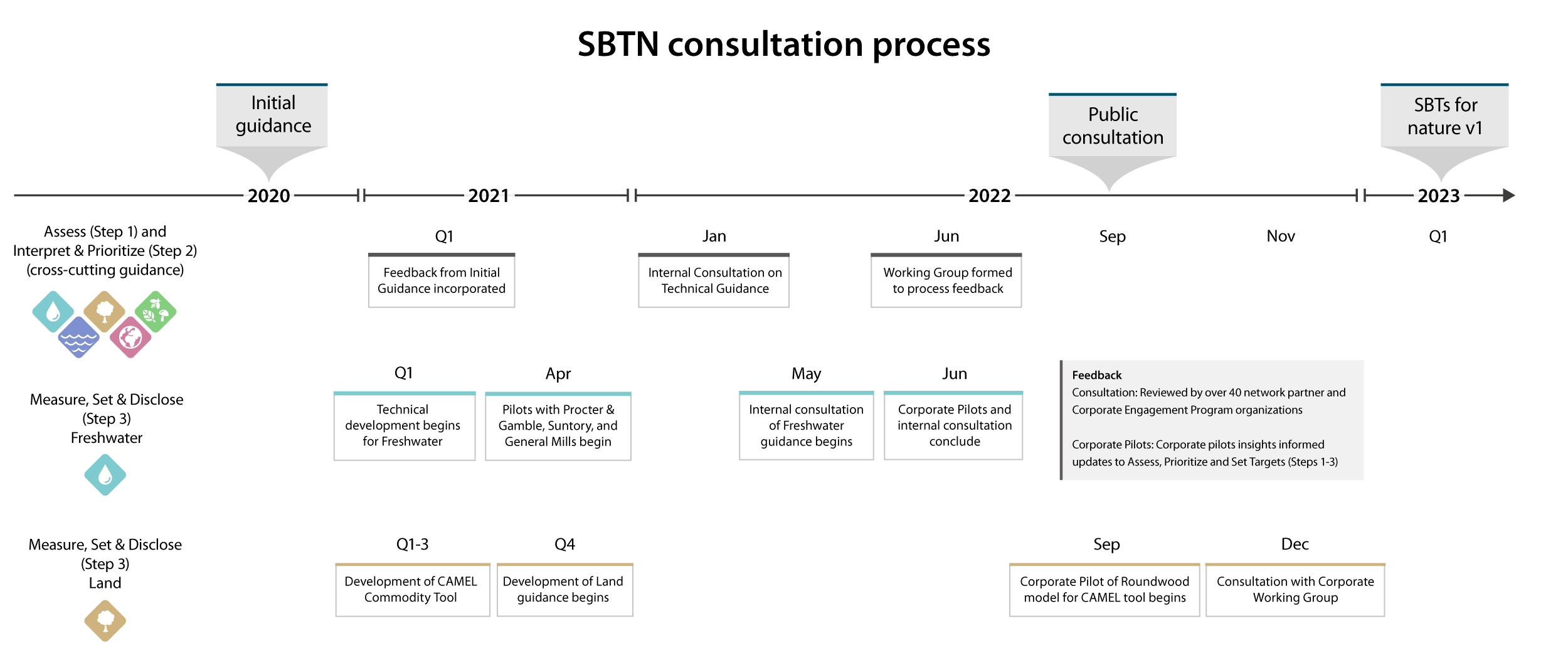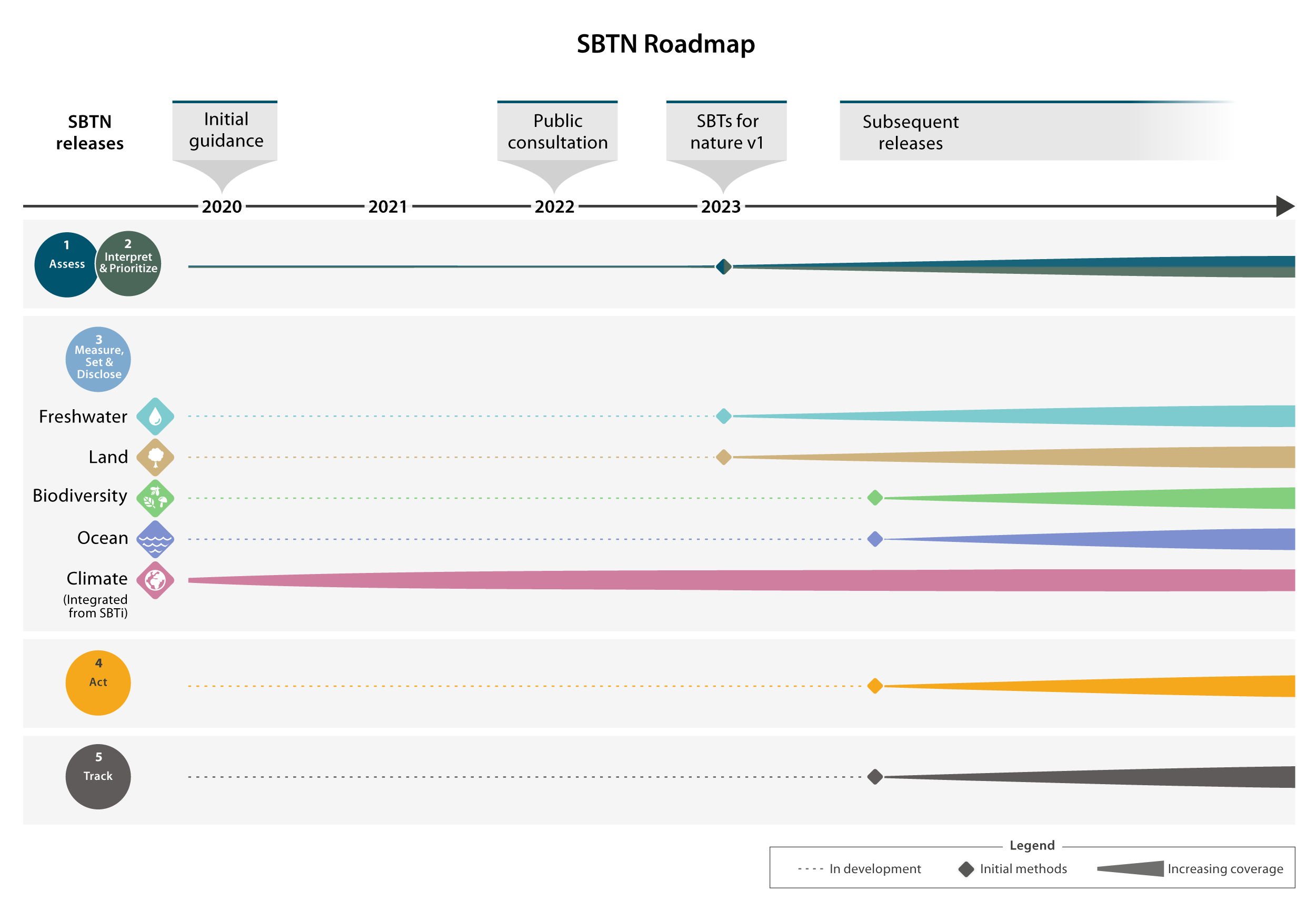
Public consultation on technical guidance for companies
Ahead of the first release of science-based targets for nature v1 in early 2023, Science Based Targets Network (SBTN) sought public comment during September 15-October 14, 2022 on its technical guidance for companies to set science-based targets for nature, with a focus on helping companies assess and prioritize their environmental impacts to then set targets, beginning with freshwater.
The environmental and social crises facing the world pose major risks to companies but also present major opportunities to those that tackle these crises simultaneously.
SBTN – a unique collaboration of over 60 leading global non-profits and mission-driven organizations – is equipping companies with the guidance they need to take science-based action towards an environmentally safe and socially just future.
To complement science-based targets for climate, which help companies mitigate their GHG emissions, and to help companies adopt a roadmap for integrated environmental action, SBTN is developing science-based targets for nature including freshwater, land, ocean and biodiversity. These corporate targets will take direct aim at the drivers and pressures fueling nature loss offering a pathway for measurable corporate action and ensuring companies are taking enough of the right actions, in the right places, at the right time.
The technical guidance in the public consultation (Sept 15-Oct 14) builds upon the first three steps of the five-step corporate target-setting framework introduced by SBTN in 2020 with the Initial Guidance for Business

The draft guidance, available for public comment between September 15-October 14 will enable companies to:
- Assess (Step 1): identify which environmental issues to set targets on, for which parts of the business
- Prioritize (Step 2): prioritize which places and parts of the business to get started on first
- Set Targets (Step 3): take action on specific material environmental issues, starting with freshwater quantity and quality (nitrogen and phosphorus initially)
Once finalized, this guidance will form the basis of SBTN’s first release of SBTs for nature in early 2023 which will will include initial target-setting resources on freshwater as well as land to complement those on climate from the Science Based Targets initiative.
Frequently Asked Questions
Get answers to key questions that SBTN is often asked
Who could provide feedback during the public consultation period (Sept 15-Oct 14)?
This public consultation marked a critical point in the development of SBTs for nature. It was the public’s opportunity to provide input into our multi-stakeholder process to ensure the finalized guidance for companies released in 2023 is as robust, clear and practical as possible.
We welcomed input from any external stakeholder that could inform the finalization of the corporate technical guidance including companies, financial institutions, consultancies, industry associations, NGOs, academics and policy-makers. Due to the technical nature of this content, stakeholders with expertise in sustainability, environmental risk management, environmental and social science, ecology and conservation are appreciated.
Can companies use this draft technical guidance now?
Until this guidance is finalized and incorporated into the release of SBTs for nature v1, the recommended starting point for companies as well as consultants, industry coalitions or other organizations looking for guidance on the target-setting journey is SBTN’s no regrets actions including assessing their impacts on nature loss through SBTN’s Initial Guidance published in 2020.
Who has reviewed the draft technical guidance so far?

The “Assess” and “Prioritize” (Steps 1 & 2) technical guidance has undergone multiple rounds of consultation and iteration, including an internal consultation with 44 network partners and SBTN Corporate Engagement Program members in January-February 2022. The final stages of development have been led by the SBTN technical team facilitated by Metabolic with a working group of technical experts from: Capitals Coalition, CDP, Conservation International, Taskforce on Nature-related Financial Disclosures (TNFD), The Biodiversity Consultancy, UNEP-WCMC, and the World Wildlife Fund,.
The “Set Targets” (Step 3) draft guidance was developed by the freshwater issue hub, led by WWF and CDP, with Pacific Institute, World Resources Institute, and The Nature Conservancy. Technical expertise was also provided by Limnotech, Earth Genome, Future H2O, and Quantis. The freshwater issue hub also led the pilots with Procter & Gamble, Suntory, and General Mills (April 2021-June 2022), throughout various parts of their value chains. The insights from these pilots have been used to update the methods for “Assess”, “Prioritize” and “Set Targets” (Steps 1-3). The “Set Targets” (Step 3) freshwater guidance was then reviewed by over 40 network partner and Corporate Engagement Program organizations during an internal consultation during May-June 2022.
Companies across 16 countries (France, United States, Switzerland, Netherlands, Denmark, Italy, United Kingdom, Japan, Sweden, Canada, Germany, Finland, Portugal, Hong Kong, Australia, Norway) and covering 9 sectors (Consulting, Consumer Staples, Materials, Consumer Discretionary, Utilities, Health Care, Energy, Information Technology, Industrials) have provided their input during the feedback periods for “Assess”, “Prioritize” and “Set Targets” (Steps 1-3) guidance.
What’s next now the public consultation has ended and what will be included in SBTs for nature v1 in 2023?
After the 4-week (Sept 15 – Oct 14) public consultation ended, SBTN technical teams reviewed feedback and updated the guidance. These are currently being reviewed by an Expert Review Panel (ERP). The ERP will provide a recommendation on whether the guidance is fit for publication by assessing it against technical criteria to understand whether the guidance will lead to positive environmental and societal outcomes, when companies apply the methods correctly.
To support the use of the technical guidance, SBTN will create a “how to” corporate manual which will serve as the primary reference point for companies on their target-setting journey.
In addition to freshwater targets, initial land targets will also be part of the first release of SBTs for nature. More information on the consultation process on the initial land targets is forthcoming.
The goal is for the corporate manual and technical guidance including initial freshwater and land targets to be published as part of SBTs for nature v1 in early 2023. Subsequent releases of SBTs for nature will increase the scope of issues that SBTN is able to cover with its guidance, in line with the latest science and development within the Network.

Does this draft technical guidance cover the entire value chain?
The technical guidance is focused primarily on enabling companies to assess and set targets on environmental impacts occurring within their direct operations, and upstream value chains (one component of Scope 3).
It does not address environmental impacts occurring in companies’ downstream value chains. As we expand the scope of the guidance in subsequent releases, environmental impacts in companies’ downstream value chains will be considered.
Is the draft technical guidance applicable to all sectors?
The technical guidance, when finalized, will be better suited to some economic sectors than others, for different parts of the value chain. For instance, companies in the food, forestry, or agriculture sector or sourcing from this sector will be able to easily use the guidance for assessing and addressing impacts in their direct operations and upstream value chains (respectively). Companies in extractive industries and construction may be able to use the guidance to easily assess and address impacts associated with their direct operations, but find more limited applicability of the upstream approaches.
We anticipate that feedback from practitioners and other experts will enable us to adapt and expand the guidance to increase their applicability.



